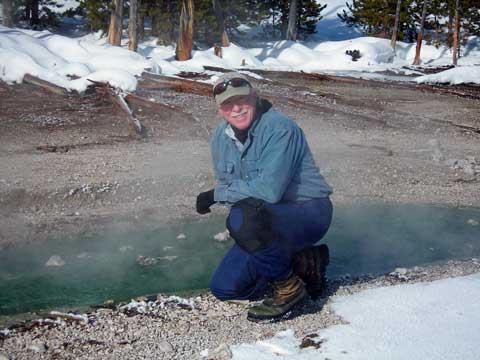Research projects have become a popular target for politicians and citizens concerned about government spending, but at least some studies do have practical applications. A recent example involves a project at Yellowstone National Park, where scientists have been in hot water for a good cause.
The hot springs and other thermal features at Yellowstone are interesting for lots of reasons, but they may seem an unlikely source for a possible solution to pollution from a deadly poison.
Arsenic is the most common toxic substance in the environment, ranking first on the Superfund list of hazardous substances, according to participants in a recent study. Arsenic is a problem in mine wastes and in massive contamination of drinking water in many parts of the world, but a discovery at Yellowstone may someday help solve those problems.
Dr. Tim McDermott, a professor at Montana State University, participated in a recent study at Yellowstone of a simple one-celled alga. The organism thrives in extremely toxic conditions and chemically modifies arsenic that occurs naturally around hot springs.
McDermott said arsenic is very common in the hot, acidic waters of Yellowstone and presents real challenges for microorganisms living in these conditions. Indeed, there are challenges for the researchers. McDermott said the acid in the soil and water is strong enough that it sometimes eats holes through his jeans when he kneels to collect samples.
The alga and how it detoxifies arsenic are described in a paper that was posted recently in the online edition of Proceedings of the National Academy of Sciences.
McDermott has worked in Yellowstone for more than a decade and travels year-round to the Norris Geyser Basin to study the microbial mats that grow in acidic springs. Over the years, he noticed thick algae mats that were so lush and green in December that they looked like Astro Turf. By June, they were practically gone. While investigating the change, McDermott and his collaborators learned about the Cyanidiales alga and its ability to reduce and convert arsenic to several forms that are less toxic than the original.
The algae grow all over Yellowstone, but the researchers concentrated on the Norris Geyser Basin. The alga thrives in water up to 135 degrees Fahrenheit (too hot to shower) with a very acidic pH factor ranging from 0.5 to 3.5. Creeks are considered acidic if their pH factor is less than 7.
"These algae live in areas of Yellowstone that are extremely toxic with respect to arsenic," McDermott said. "You couldn't drink these waters even if you changed their pH."
A Harvard University website notes that
Arsenic contamination has become a problem in many parts of the world, first as a result of leaching from mine tailings in Australia, Canada, Japan, Mexico, Thailand, United Kingdom, and the United States, but now also from the arsenic in natural aquifers now or recently used for water supply in many countries, including the U.S.
There are other potential practical applications for the Yellowstone findings.
A 10-year study at Dartmouth College confirmed that microbes in garbage buried in landfills can react with iron oxides in the soil, resulting in the release of arsenic into groundwater. When water flows through the landfill, arsenic can become incorporated into drinking water. Over a long period of time, this can cause serious health problems, according to the EPA.
Funding for the study came from a variety of sources, including the National Science Foundation and the National Institutes of Health—not the National Park Service.
Regardless of the eventual use of this discovery, this work is further proof that the value of resources found in national parks extends far beyond tourism and spectacular scenery.




Comments
Yellowstone ought to be classified ad superfund cleanup site. It's national park classification happened in 1872, before we knew anything about industry produced toxins. Tremendous geothermal electricity potential being ignored due to ignorant misclassofication.
Thank you Traveler for an interesting post. The science research in Yellowstone may help us reduce the problems of toxic waste in mining dumps, landfills, etc. Thanks to those working on the issue.